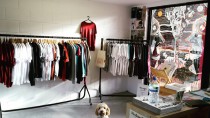It made for a pleasant change recently to down tools, hang up the overalls and meet with Stephen Cappello, winner of the recent Shadow Screen competition, to discuss with Damien and Genny from ISO the next steps in realising the design.
On the face of it, the process of making a striking, freestanding, screen using Stephen’s Braille based pattern seemed fairly simple – just apply to an existing template that works well, take a few photos and and hey presto, new product launched. But much as I’m a fan of the path of least resistance, it didn’t seem appropriate to knock out more of the same. In fact, the three panel folding screen that is the most clearly identifiable image of the Shadow Screen range is not really a ‘product’ in the conventional sense – it was created for a Beruit Spa, who needed a lightweight, moisture resistant, folding screen. The impetus for it’s development was context driven, and like all good design, it justified it’s presence by creating value in response to this context.
The dilemma of speculative product design is that it has no real context, or at best an assumed one, and so its claim of creating value rests on the believability of a fiction. Because the Shadow Screen service creates value by responding appropriately to the needs of particular contexts, through the means of screening, filtering and defining threshold space, it seems counter intuitive to choose fictional context over reality. Context is arguably essential to showing the value of the Shadow Screens, and particularly so if the winning design is to be used to show the potential of the collaborative work.

The judging panel were attracted by Stephen’s design not only it’s simplicity and economy, but also by the potential to encode site specific content into the work. The digitally based means of fabrication inherently offers freedom from the constraints of tooling set up costs, and the best design has always fully exploited the potential of production. it makes an enormous amount of sense, therefore, for the made design to respond to real contexts, not only formally, but through site specific content. Buildings have long been judged on their appropriateness to context. It will be fascinating to see if product design, like the best architecture, can respond intelligently to place.














Comments